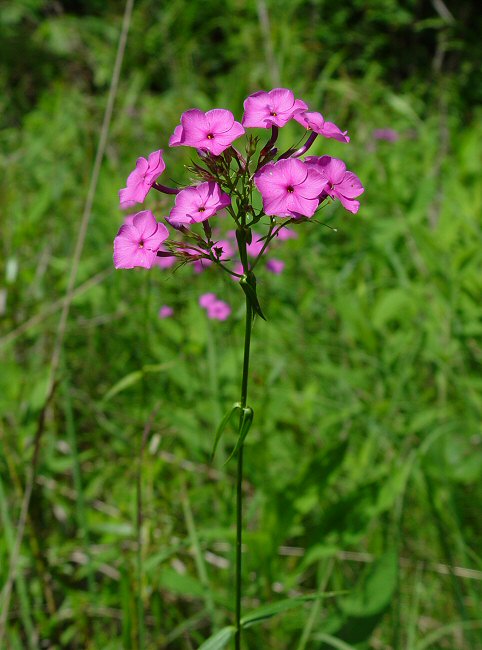Phlox glaberrima L.
Smooth Phlox

Native
CC = 8
CW = -3
MOC = 16
© DETenaglia
Phlox glaberrima L.Smooth Phlox | |
 |
Native CC = 8 CW = -3 MOC = 16 |
© DETenaglia |
|
Family - Polemoniaceae Habit - Perennial forbs with fibrous roots and short, thick rhizomes. Vegetative offshoots not produced. Stems - Erect, usually solitary and unbranched, to 1 m, with 10-22 nodes, usually glabrous, not noticeably streaked with red or purple.
Leaves - Opposite, sessile, decussate, the lowermost with the blades mostly linear, grading to narrowly lanceolate or narrowly elliptic (rarely more broadly lanceolate) toward the tip, angled to a sharply pointed tip, tapered to angled or rounded at the base, those of the largest leaves 6-14 cm long and 4-20 mm wide, the surfaces glabrous, the upper surface shiny, light green below, the margins sometimes somewhat rolled under, appearing glabrous but with microscopic, forward-angled teeth (visible only with magnification), the secondary veins obscure, pinnate and not forming conspicuous loops.
Inflorescence - Terminal, with 12-100 flowers, consisting of clusters, the aggregate of clusters often appearing as domed panicles (about as long as wide). Flower stalks 2-7 mm, essentially glabrous. Inflorescence divisions subtended by linear bracts.
Flowers - Calyces 5.5-10.5 mm long, the lobes triangular to narrowly triangular, tapered evenly to sharply pointed tips, glabrous. Corollas salverform, light pink to pink or pinkish purple, the tube 14-22 mm long, glabrous externally, lacking a basal constriction, the 5 lobes 7-10 mm long and 6-9 mm wide, obovate, rounded at the tips, glabrous. Stamens 5, the filaments 9-21 mm long, the anthers positioned from below to at or above the stigma near the mouth of the tube (occasionally 1 or 2 slightly exserted). Style 9-20 mm long, the 3 stigmas yellow, 0.6-1.3 mm long. Overy superior, green, glabrous, ovoid, 1.3 mm long in flower, 1 mm in diameter, subtended by a green ring-like nectary, 3-locular, with 3 ovules. Placentation axile.
Flowering - May - July. Habitat - Fens, acid seeps, streambanks, bottomland prairies, bottomland forests, swamps. Origin - Native to the U.S. Lookalikes - Several other species of Phlox. Other info. - This attractive species can be found mainly in the southeastern corner of Missouri. Beyond Missouri its range encompasses much of the southeastern quadrant of the continental U.S., though it is not particularly common due to its habitat requirement. It is differentiated by other species of Phlox by its wet habitat, green stems, and narrow leaves which are glabrous and shiny on top. This is a striking plant which makes a great garden subject in moist areas of full sun. Photographs taken in Ripley County, MO., 6-5-04 (DETenaglia); also aat Poplar Bluff Conservation Area, Butler County, MO, 5-15-2016 (SRTurner). |